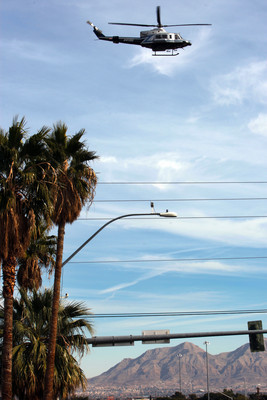Copter checks radiation levels
A low-flying helicopter that thundered over North Las Vegas neighborhoods Wednesday was on a training mission for the National Nuclear Security Administration.
An agency spokesman, Kevin Rohrer, said the gray, Bell-412 helicopter with blue stripes was dispatched from the agency's Remote Sensing Laboratory at Nellis Air Force Base on a training proficiency mission.
The flights, in which the helicopter flies grid patterns about 150 feet above ground are done "on a regular basis so pilots and technicians can continually update their skills on how to do radiation surveys from the air," he said.
"We fly these missions so we can distinguish background radiation from other anomalous sources," Rohrer said.
He said Wednesday's exercise was coordinated with the North Las Vegas mayor's office. The office had requested some aerial photography.
In addition, Rohrer said, the radiological data will be shared with North Las Vegas to establish baseline radiation levels in the community.
"In the future, if somebody ever wanted to background radiation in a given area, we could fly over and provide that to them," he said.
The aerial detection instruments are sensitive enough to locate isotopes in gauges used by the construction industry to measure the density of concrete structures, roadways and building materials.
"If one of those would happen to be out in the community in use, we would see that with our radiation detection equipment," Rohrer said.
He said additional proficiency training missions involving the Remote Sensing Laboratory's helicopter might be flown over the Las Vegas Valley in the near future.
In December 2003, the FBI sought the help of the Department of Energy's ground-based radiological detection gear in checking out a suspicious radioactive material in a local storage facility.
Scientists from the National Nuclear Security Administration, an autonomous Energy Department agency, later determined the source to be radium, like that used to treat cancer. It was in a tube the diameter of a nickel and less than 2 inches long.
At the time, authorities had feared that larger quantities of the isotope could have been used as an ingredient for a so-called "dirty bomb," created by terrorists to spread deadly contamination.

















